by Scott Howard | Dec 5, 2016 | Marketing and Advertising Insights, ScLoHo's Media, The Not-So-Secret Writings of ScLoHo
So really…Is Traditional Media Dead?
I’m going to look at this subject from a marketers perspective. And a consumers viewpoint. And focus on just one piece of the traditional media, daily newspapers.
Lots of businesses rely on traditional media and advertising options that have been the mainstay for decades. Radio, television, yellow pages, magazines and newspapers were the big ones.
Every one would get a phone book that included a yellow page section that businesses would pay for ad space so you and I as consumers could find a plumber or lawyer or whatever we needed that we didn’t already have.
The internet replaced the relevancy of the printed yellow pages as cellphones replaced land lines and printed phone books that were updated months in advance and published once a year became obsolete.
(I’m still listed in the printed phone book white pages with an address that I moved from 11 years ago and a phone number I disconnected 3 years ago.)
But let’s focus a second on the other printed form of advertising that is updated nearly every day.
Your local newspaper. A decade ago I predicted the death of their business model at the same time our local papers built a new multi-million dollar press and building. It was a stupid idea, but it didn’t kill the paper.
Last month a friend of mine who comes into the Firefly Coffee Shop everyday to do crosswords and drink a Venti cup of coffee told me he is in the Sunday newspaper. Jim is his name and Jim is in his 70’s. He told me that his picture was in the business section.
While Jim was looking around the coffee shop for a copy of the Journal-Gazette Business section to show me the picture of him, I sat at my laptop and found it and the story.
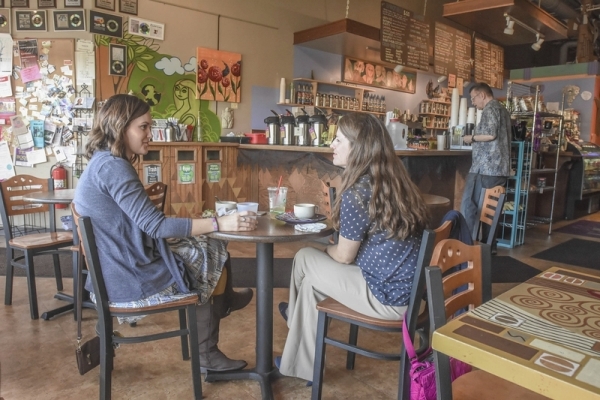
Jim was surprised that I could find nearly any story from the printed copy of the newspaper on their website. Here’s the irony:
Jim did not read the story in the newspaper and so he did not know the context of the picture except the picture was of two women and he was in the background. The headline read: Youth also flavor local java scene and it was about the increase of millennials visiting coffee shops.
As both technology changes and generations age, there is a shift in the way the public consumes media and gathers information. Many newspapers allow you to read a limited number of articles online free but the goal is to have you pay with an online subscription.
The newspaper business model is broken and attempts to fix it appear futile. The company I work for, Federated Media sold off the one newspaper they owned this year because it was not profitable. At least compared to the other media assets under the company umbrella. Without my personally speaking to the Dillie family that owns our company, I still know that the newspaper was a prized piece of the portfolio of media interests, and the sale of the paper was strictly a business move that they wished they didn’t have to do.
Mediapost shared some stats about newspaper revenues that include:
Gannett reported an 11.7% year-on-year drop in its third-quarter ad revenues and a 6.4% drop in its circulation revenues
Print advertising revenues for the three months that ended on September 25 fell 14.8%, led by a 35.1% reduction in national print advertising and a 19.1% reduction in preprints.
On the positive side, they shared this:
Digital advertising revenues were up 6.2%, compared to the quarter a year ago, Digital-only subscriptions grew 45%.
However:
Gannett plans to lay off roughly 350 employees, or around 2% of its total workforce of about 18,700.
Gannett, which is the nation’s largest newspaper publisher, with a portfolio that includes USA Today and more than 100 local publications
Layoff announcements like this are not new. They are continuous. These are not like the old layoff announcements companies used to make about temporary layoffs. These jobs are not coming back.
The online version of newspapers is not capable of supporting financially the printed version.
The short story on these and other numbers is that the newspaper business is still trying to stay alive but when they finally do find a formula that makes it possible to survive financially, it will be a tiny fragment of what we have now in 2016. And what we have now in 2016 is a fragment of what the newspaper industry was 20 years ago.
As a consumer, I don’t need the printed paper to stay informed. If the online version goes away, we’ll have other online news sources that don’t have the burden of overhead.
As an advertiser, the number of print readers I reach by ads in the newspaper will continue to grow old and die. I went to a funeral of a 95 year old this fall so we may be living longer, but like my friend Jim who is in his 70’s and his picture is in the paper, it doesn’t matter anymore.
Thoughts? Questions? Comments? Let’s talk.
by Scott Howard | Nov 1, 2016 | Marketing and Advertising Insights, ScLoHo's Media, The Not-So-Secret Writings of ScLoHo, WOWO Fort Wayne Radio Advertising with Scott Howard
Over the next 5 weeks, I am sharing the 5 most shared articles I’ve published in the past 12 months. As we prepare for the final week of the 2016 Election cycle, this look back on the 2015 election still has some truths to consider:
WOWO Radio in Fort Wayne is recovering from the November elections that we just had a week ago today. While it was an off year for Federal and state offices there were many local offices up for grabs including City Clerk, Mayor and City Council.
(I’ll tell you why I used the word recovering in a moment.) 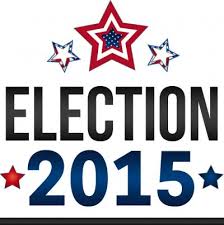
WOWO has been on the air at 1190 am for 90 years and News/Talk for around 20 years.
As the most listened to radio station by adults combined with the news/talk format, it’s a magnet for politicians to place ads so they can stay in office or upset an incumbent.
We are obligated to accept political advertising from the candidates official campaigns and charge them the same price. At Federated Media, all of our political advertising is handled by our station General Sales Managers. I had a candidate contact me and I passed him on to Ben, the G.S.M. for WOWO.
The reason I say recovering is we had to be very creative and work with some of our advertisers who gave us flexibility in when their ads would air to jockey around some of the ads since we have a limited number of ads we can air each week.
Some of the ads that would have aired in October for some advertisers are going to air next week, for example.
Radio ads and yard signs are two of the most popular ways politicians spend money to get elected. I saw a story last week that Donald Trump and Ted Cruz are investing in radio ads for winning primary contests.
Why? Radio works.
But what about T.V.? Let me dig into what happened in the Fort Wayne City elections last week.
Republican Mitch Harper spent money on radio and T.V. along with plenty of other medias to unseat our Democratic Mayor Tom Henry. Mitch lost.
One might expect that since the Democratic candidate for Mayor won, many voters would vote a straight ticket and elect Democrats to the other city offices. Wrong.
The 3 City Council at Large seats were won by Republicans. I bet the 3 top vote-getters are the 3 that advertised the most on WOWO Radio. And I suppose that if Republican Mitch Harper had spent more on radio ads and less on TV ads, he could have been preparing for his first term as Mayor of Fort Wayne.
You may not care about politics, but you can learn from the successes and mistakes that our politicians make during a campaign.
by Scott Howard | Sep 20, 2016 | Marketing and Advertising Insights, ScLoHo's Media, ScLoHo's Web World, The Not-So-Secret Writings of ScLoHo, WOWO Fort Wayne Radio Advertising with Scott Howard
It’s a question that some people ask out loud and others may not ask me directly but they are thinking, “Why Does a Radio Guy Also Sell Digital Marketing Solutions?”
Excellent question.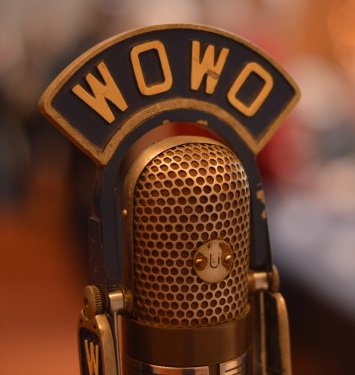
Here’s the answer.
My background is in radio. From the time I was 16 until I was 26, I loved being on the air. Then I moved over to the business side creating ad campaigns in Detroit for my radio clients. I became a student and teacher of marketing, advertising, sales, persuasion, and something I call human relationship marketing.
Jump ahead to 2005 and I started using digital (the web) to market myself using the same concepts I had learned 15+ years earlier.
With me, Scott Howard aka ScLoHo, you get to work with an individual who understands both the traditional broadcast world and the newer digital world. I walked away from my paying jobs in radio twice in recent history to work full time in the digital world. The first time was in 2011, when I joined a website development firm. A couple years later, I joined a multi-million dollar e-commerce biz as their Social Media director.
Now I work for WOWO radio which is one of the stations owned by Federated Media. Federated Media also has a digital division, Federated Digital Solutions. 
Federated Media created Federated Digital Solutions because many of their radio advertising clients were also looking for ways to market themselves online. Federated Media decided to invest in creating another division of the company. During my three years, I have seen our digital division grow and we now have 20+ people working for Federated Digital Solutions.
Those 20+ people at Federated Digital Solutions (FDS) have a wide range of backgrounds and experiences. The goal was to find the best available talent in the country and create the FDS team.
But there’s more.
Several of the digital solutions use outside vendors that we have access to that you simply can’t buy on your own. We also have two layers of expertise working on all of these digital marketing campaigns. There’s the expertise of our vendors and the expertise of the FDS team.
With me, you actually get a 3rd layer of expertise. Me. Scott Howard aka ScLoHo.
Because of my background, experience and knowledge, I really do know more than most of my radio co-workers. No, I’m not a know-it-all, but I do know how to Google to get the answers on stuff that I don’t know.
Here’s something else that’s important.
I care more about my reputation than what I sell.
I care more about your success than what I sell.
When I started at WOWO, I sold next to nothing from the digital solutions offered by FDS. I wanted to see the results and I wasn’t willing to use my advertising partners as test subjects. But as I watched, observed and questioned, I saw that the performance of the Federated Digital Solutions team was top notch. I also got the opportunity to see what other companies were selling and through that comparison, I saw how we were superior to others.
I’ve seen what Nexstar Broadcast Group was trying to sell as digital solutions and it was crap.
I’ve seen the actual results of Dex Media and what they sold to come of my advertising clients and did digging and found a huge pile of manure.
There are a couple of local companies that are selling digital marketing solutions that are worthless. My friend Kevin, called it marketing malpractice when we were discussing what I was seeing, and Kevin is one smart dude when it comes to doing digital marketing correctly.
Advertising agencies, both local and national are understaffed and under-qualified to be doing the digital work they are selling.
This summer I found out one of my advertising partners bought a website for $27,000 from one of these advertising agencies and it’s really messed up. Sure it looks okay to the naked eye, but it is impossible to optimize for the search engines (SEO) due to the platform they built it on. We can rebuild it for less that 1/3 that cost.
One last item in answering the question, “Why Does a Radio Guy Also Sell Digital Marketing Solutions?”
There actually is a study that shows how broadcasting works best in driving people to your website. A couple lines from the article that caught my eye:
Here’s why radio and TV have the advantage: While print media requires hands, broadcast media leaves them free to do other things . . . like type in a URL, tweet something, or click “like.”
Want to talk? Let’s connect
by Scott Howard | Sep 5, 2016 | Marketing and Advertising Insights, ScLoHo's Media, The Not-So-Secret Writings of ScLoHo
I recall a few years ago watching the Emmy awards and wondering if any of the major broadcast networks were going to win any awards.
By broadcast networks, I mean the networks that you can watch over a traditional television without cable or internet. In most cities that includes ABC, CBS, NBC and sometimes FOX, CW and MY networks. PBS too.
As I was reviewing emails from the summer I saw one from MarketingCharts/MediaPost that pointed out a generation gap in how we watch. This study actually counts satellite and cable tv as part of the traditional tv group
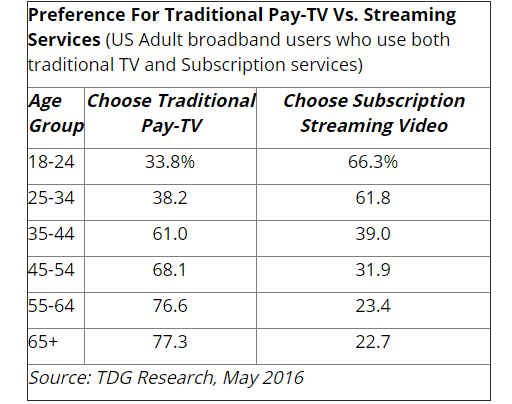
From the looks of it, it appears that the current batch of 40 year olds are at the age of switching from watching live traditional TV to other delivery methods such as streaming or delayed viewing on other devices.
My kids are definitely watching plenty of streaming video compared to traditional television. My wife and I are over 50 and we watch streaming video too because of the convenience of it.
My guess is that the switch is not just because of our ages, but the switch will accelerate as more and more older adults become aware of the choices they have.
And now a note of caution for the businesses that are relying on their local television stations to advertise with… The audience isn’t just getting older, it’s shrinking too and will not be coming back.
How much traditional TV did you watch over this Labor Day Weekend versus how much streaming video did you view?
by Scott Howard | Jul 13, 2016 | Marketing and Advertising Insights, ScLoHo's Media, The Not-So-Secret Writings of ScLoHo
I’m just going to toss out a few items and you can fact check them if you want because I’m not going to hyperlink the sources, there’s too many and I’m sort of busy these days.
I want you to answer a question… that question is what are you doing differently?
If you are using the same media mix to advertise that you were using in 2013, you need to re-evaluate. Some of the media platforms you’ve been using have lost viewers/readers/listeners. Other media platforms that were just getting started back then have become worthy of consideration.
Think about that pocket computer known as your phone. Every 18 months the technology capabilities of our computers doubles. The phone you got for Christmas, 2014 is old, broken, out of date, or you’ve already replaced it.
As I was writing this piece last week, I was using 3 screens. My laptop, my phone and I was watching America’s Got Talent on the flat screen in our family room.
A few days ago I was watching a TV show on Amazon Prime, streamed from my laptop to another TV via my Chromecast.
Every day I hop in my car and listen to at least 4 different radio stations. Besides listening as I drive, I sometimes hear a radio station when I stop to pick up my breakfast and I also sometime listen to the streaming of my favorite stations by plugging earbuds into my laptop as I have my afternoon coffee.
I don’t remember the last time I bought the local newspaper, or any newspaper for that matter. I have read stories from the papers, but it’s because I get a link on Twitter or Facebook that captures my attention and I click and read.
Those are some of the media habits I live every week in the summer of 2016. Some I’ve been doing for years, others for just months.
What about you? What is different about your media habits compared to a few years ago?
Your customers have changed some of their media habits over the years too. My question for you is have you changed your media mix to take advantage of the changes that are going on all around us?
What are you doing differently? If you want help figuring this out so your business can make money, contact me so we can talk.
by Scott Howard | Jul 6, 2016 | Marketing and Advertising Insights, ScLoHo's Media, ScLoHo's Web World, The Not-So-Secret Writings of ScLoHo, WOWO Fort Wayne Radio Advertising with Scott Howard
Around the radio station we talk about offering a “CAT” advertising solution as one of the methods to help our advertising partners.
But most of you are clueless if I were to ask you, “Do You Know What C.A.T. Is?”
That’s alright because I’m going to take a couple days to explain.
First off C.A.T. is a made-up word. 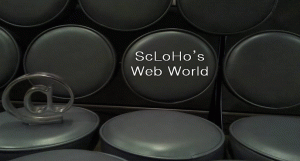
But that’s okay, because it’s an acronym for something pretty spectacular that is offered exclusively by Federated Media, the parent company of my radio station WOWO in Fort Wayne, Indiana. We have a digital division called Federated Digital Solutions, and C.A.T. is one of the solutions.
C.A.T. stands for Custom Audience Targeting. Here’s why those three words were selected.
Imagine if you could targeting your advertising so only specially qualified individuals saw or heard your ad?
If this was possible while watching T.V. that means the ads that you see while watching your favorite show would be different than the ads I see, while watching the same show at the exact same time!
Say you are into Country Music, and I’m more of a Classic Rock fan, you’d see ads for the upcoming country concert coming to town and I’d see some old rockers concert commercial.
So far, that’s not possible. It’s not possible with television, radio, print ads, billboards either.
But it is possible with the power of digital display ads. These are the ads that seem to follow you around after you’ve been to a website and ads for that website appear when you’re off looking up something else online.
What I just described is called Retargeting and it works by the website you visited placing a pixel or cookie on your web browser. Retargeting is the oldest form of this digital display ad technology.
When I combine it with three other methods of finding the right target for your ads, it can be pretty powerful.
Those three other methods include Search Retargeting, Contextual Retargeting and GeoFencing. Together, these 4 methods of finding the right audience for your digital display ads combined with other qualifying data helps us to create a Custom Audience Target.
Curious about how this works? Contact me and I’ll show you.









